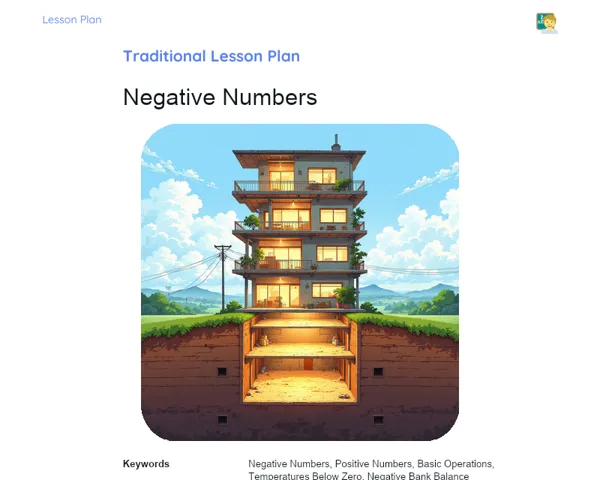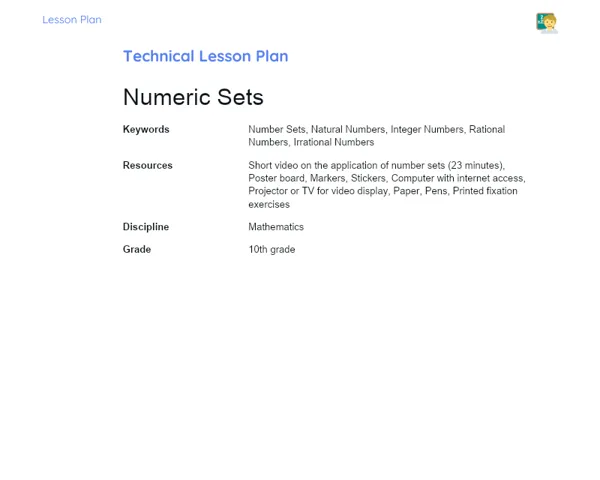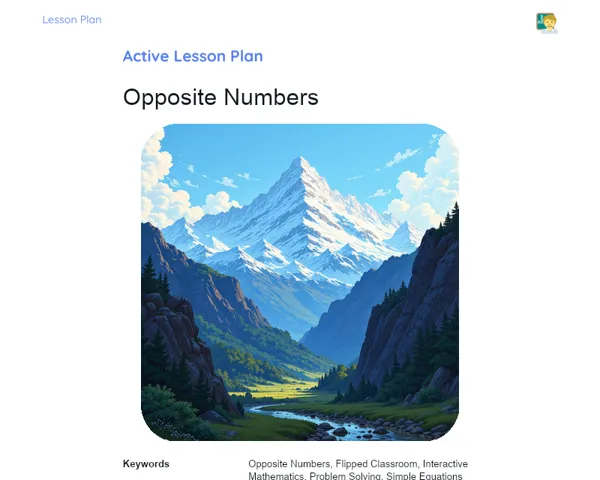Lesson Plan | Socioemotional Learning | Triangles: Law of Cosines
| Keywords | Law of Cosines, Triangles, Mathematics, Self-Knowledge, Self-Control, Responsible Decision-Making, Social Skills, Social Awareness, RULER, Emotions, Problem-Solving, Teamwork, Reflection, Emotional Regulation |
| Resources | Whiteboard and markers, Scientific calculators, Worksheets with triangle problems, Pencils and erasers, Note paper, Clock or timer, Computer with internet access (optional), Projector (optional) |
| Codes | - |
| Grade | 10th grade |
| Discipline | Mathematics |
Objective
Duration: (10 - 15 minutes)
This step aims to introduce learners to the law of cosines, highlighting the significance of grasping the formula and its practical applications. This introduction will help students make connections between mathematics and real-world situations, while also developing an awareness of the emotions that may arise when tackling new mathematical challenges. By doing so, we foster a safe and welcoming classroom environment.
Objective Utama
1. Grasp the formula of the law of cosines and learn how to apply it to solve triangles.
2. Develop skills to identify and calculate the sides and angles of a triangle using the law of cosines.
Introduction
Duration: (20 - 25 minutes)
Emotional Warmup Activity
Deep Breathing for Focus and Clarity
Deep Breathing is a mindfulness exercise designed to enhance focus, presence, and concentration. By paying attention to their breath, students can ease anxiety and stress, creating a calmer, more receptive classroom atmosphere. This simple yet powerful practice paves the way for a smooth transition into the lesson, allowing learners to feel more attuned to themselves and the material at hand.
1. Ask the students to sit comfortably in their chairs, with feet flat on the floor and hands resting on their laps.
2. Instruct them to either close their eyes or gently fix their gaze on a point in front of them.
3. Guide them to breathe in deeply through their nose, counting to four as they inhale.
4. Ask them to hold their breath for a count of four.
5. Instruct them to exhale slowly through their mouth, again counting to four.
6. Repeat this breathing cycle for five minutes, encouraging students to focus on the sensations of their breath and set aside worries.
7. Conclude by inviting students to slowly open their eyes and refocus on the classroom, ready to engage in the lesson with purpose and clarity.
Content Contextualization
The Law of Cosines serves as a vital mathematical tool, applicable in various everyday contexts, from navigation to engineering and construction. For instance, it can help calculate distances between two points on a map or determine ramp slopes, providing both practical solutions and precise results. Additionally, mastering this law enhances students' problem-solving and critical thinking capabilities, which are invaluable both in school and later in life.
While addressing this content, it’s essential to recognize that mathematics can sometimes stir feelings of anxiety or frustration. However, by understanding the emotions tied to learning and employing emotional regulation techniques, students can flip these challenges into opportunities for growth—both personally and academically. Hence, learning the Law of Cosines not only bolsters academic prowess but also nurtures emotional maturation, equipping students to approach complex situations with confidence and resilience.
Development
Duration: (60 - 70 minutes)
Theory Guide
Duration: (25 - 30 minutes)
1. Definition of the Law of Cosines: The Law of Cosines relates the lengths of a triangle's sides to the cosine of one angle. The formula is: a² = b² + c² - 2bc cos α, where 'a', 'b', and 'c' are the sides of the triangle and 'α' is the angle opposite side 'a'.
2. Utility of the Law of Cosines: This law is particularly handy when we know two sides of a triangle and the angle between them, enabling us to find the third side. It also helps us find an angle when all three sides of a triangle are given.
3. Example 1: Consider a triangle with sides b = 7 cm, c = 10 cm, and the angle between them _α = 60°. To find side 'a', use the formula: a² = 7² + 10² - 2(7)(10)cos(60°) => a² = 49 + 100 - 140(0.5) => a² = 49 + 100 - 70 => a² = 79 => a = √79 => a ≈ 8.89 cm.
4. Example 2: If a triangle has sides a = 8 cm, b = 6 cm, c = 5 cm and you want to find the angle 'α' opposite to side 'a', rearrange the formula to find the cosine of the angle: cos α = (b² + c² - a²) / (2bc) => cos α = (6² + 5² - 8²) / (2(6)(5)) => cos α = (36 + 25 - 64) / 60 => cos α = -3 / 60 => cos α = -0.05. Find 'α' using the inverse cosine function: α = arccos(-0.05) => α ≈ 93°.
5. Analogies: View the Law of Cosines as an extension of the Pythagorean Theorem for non-right triangles. The Pythagorean Theorem states that in right triangles, c² = a² + b². The Law of Cosines adds an extra term to accommodate any triangle.
Activity with Socioemotional Feedback
Duration: (35 - 40 minutes)
Solving Triangles with the Law of Cosines
In this activity, students will partner up to tackle practical problems using the Law of Cosines. They will calculate sides and angles of triangles with varying datasets. This exercise aims to enhance both mathematical understanding and socio-emotional skills, such as collaboration, communication, and managing emotions during challenges.
1. Divide the class into pairs.
2. Hand out worksheets with a variety of problems that necessitate using the Law of Cosines.
3. Instruct each pair to work together to solve the problems, discussing their methods and verifying their answers with each other.
4. Roam around the classroom, providing support and encouragement, and assisting groups in overcoming challenges and keeping focused.
5. Once they’ve solved the problems, ask each pair to present their solutions and strategies to the class.
Discussion and Group Feedback
After the activity, host a class discussion to apply the RULER method. 🗣️ Recognize: Invite students to reflect on the emotions experienced during the activity. Did they feel frustrated, excited, or anxious? Understand: Discuss the reasons behind those feelings—was it the complexity of the problems, the partnership dynamic, or something else? Name: Encourage precise identification of their emotions. Express: Allow students to share how they managed those feelings during the task. Regulate: Guide the class on effective strategies for regulating emotions in future activities, perhaps through deep breathing or strategic pauses for reflection.
Motivate students to share strategies they found helpful in maintaining emotional composure and effectiveness during group work. This discussion will bolster self-awareness, self-regulation, and social skills, cultivating a more collaborative and emotionally intelligent learning environment.
Conclusion
Duration: (10 - 15 minutes)
Reflection and Emotional Regulation
For the reflection and emotional regulation activity, have students write a short paragraph about the challenges encountered while applying the Law of Cosines during the lesson. They should identify the emotions they felt, such as frustration, excitement, or anxiety, and describe their coping strategies. Alternatively, facilitate a group discussion where students can articulate their experiences and share helpful emotional regulation strategies. This reflective moment aids in raising emotional awareness and developing self-management skills.
Objective: The goal of this section is to foster self-assessment and emotional regulation among students, helping them pinpoint effective approaches to managing challenging scenarios. By contemplating their emotional responses and regulation methods, students can enhance their self-knowledge and self-control—both vital for personal and academic growth.
Glimpse into the Future
To wrap up the lesson, encourage students to set personal and academic goals linked to the material covered. These goals could include applying the Law of Cosines in real-world situations, such as engineering tasks or navigation challenges, or advancing their overall mathematical skills. Urge students to jot these goals down and share them with the class or keep them for future reference. Emphasize the importance of establishing clear, measurable goals to facilitate continuous growth and motivation.
Penetapan Objective:
1. Apply the Law of Cosines to a real-life issue beyond the classroom.
2. Review the Law of Cosines formula and practise with extra exercises.
3. Increase confidence when addressing challenging mathematical issues.
4. Enhance teamwork abilities and communicate mathematical solutions effectively.
5. Utilise emotional regulation techniques to maintain focus and calm during intricate tasks. Objective: The aim of this section is to bolster students' independence and the practical application of their learning, promoting ongoing academic and personal development. By setting personal and academic goals, students are encouraged to apply the lesson's content in various contexts, cultivate self-management skills, and remain motivated in their educational journey.



